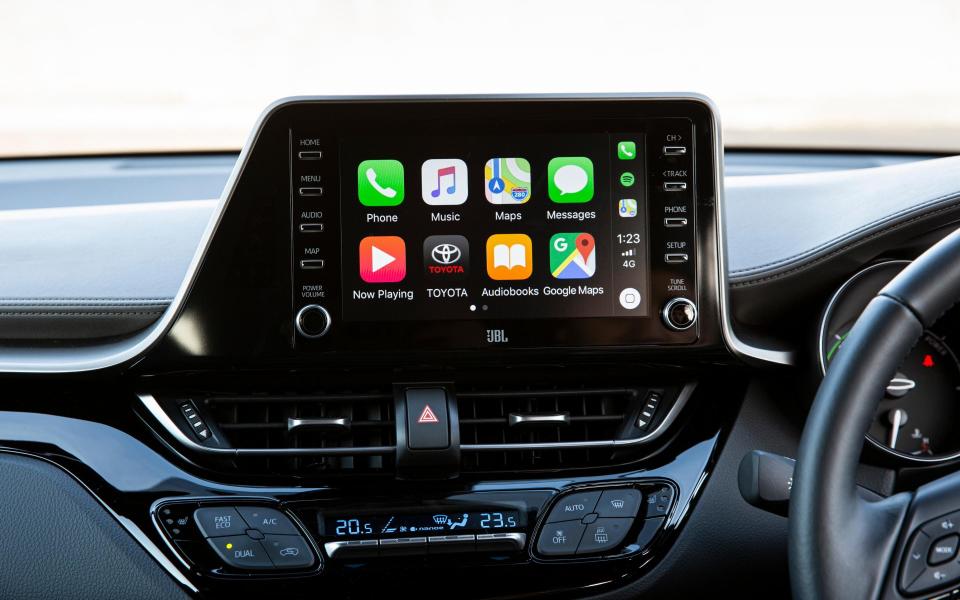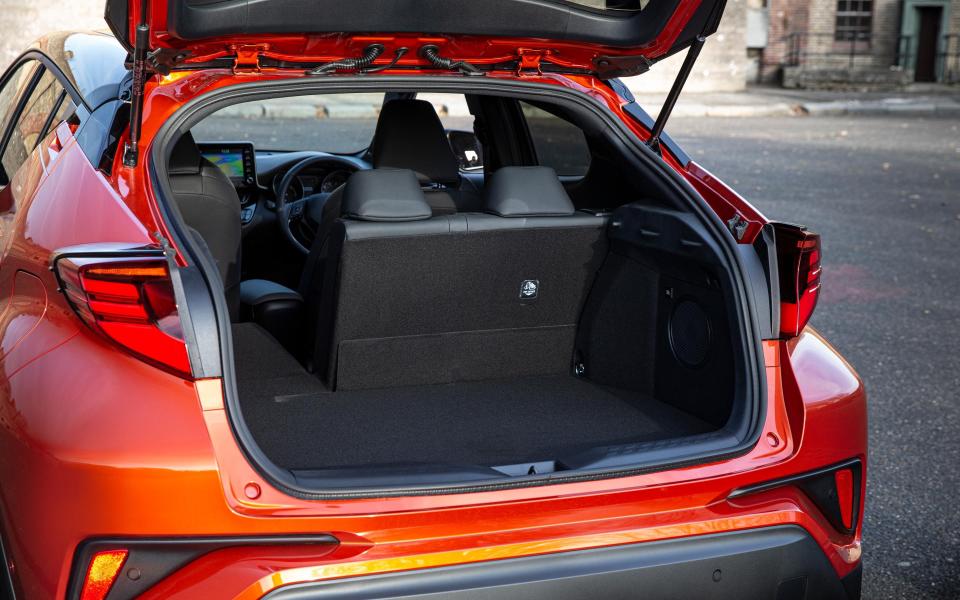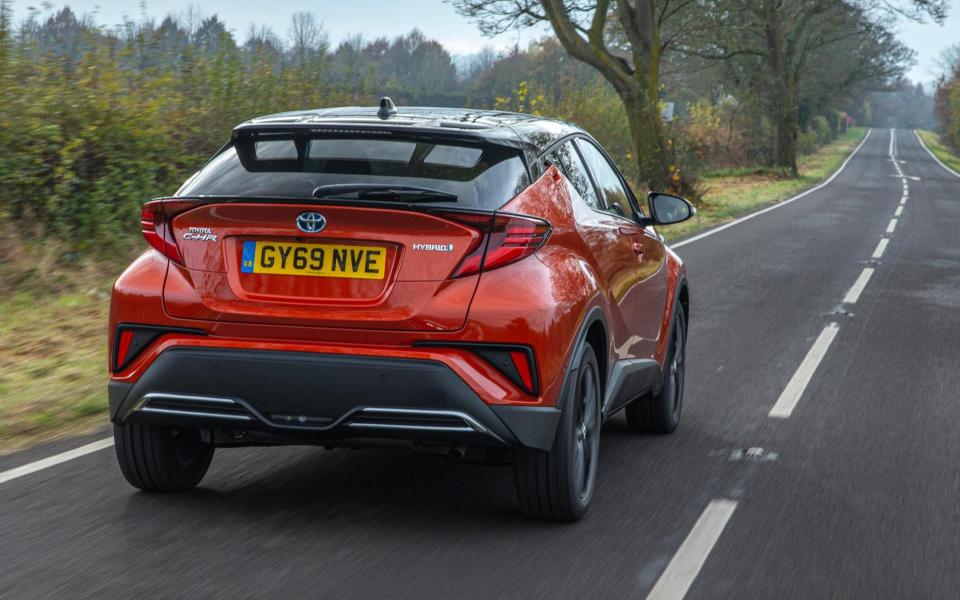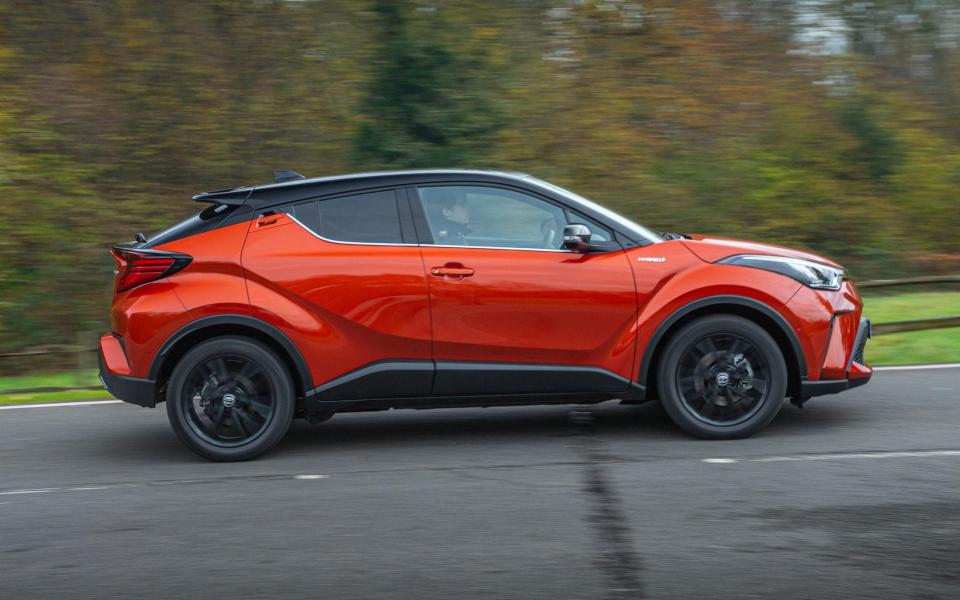Toyota C-HR Hybrid review: the stylish SUV just got a whole lot better

Do you love it, or do you loathe it? Chances are you’ll fall into either of those two camps. The Toyota C-HR’s concept-car-for-the-road looks certainly divide opinion, and have done since it was launched in 2016.
What can’t be denied is that it stands out from the crowd. And if you bemoan identikit hatchbacks and SUVs, that’s surely to be celebrated, whether you’re a fan of its wild curves and creases or not.
The C-HR’s sales success suggests quite a few people are; it’s proven a bit of a hit for Toyota, stealing sales from the Nissan Juke and Peugeot 3008 in the process. Of course, the zeitgeisty 1.8-litre hybrid powertrain hasn’t hurt it either, despite the fact the 1.2-litre non-hybrid has always been a slightly better car to drive.
But now, Toyota has shoehorned in the much-vaunted 2.0-litre hybrid from the Corolla, and while it’s done so, it’s given the C-HR a bit of mid-life botox. Time, then, to find out whether this extrovert family car still warrants its popularity; read on and register or login to find out our decisive verdict.
Pros: Good ride and handling balance, excellent new hybrid option, impressive reliability record
Cons: Claustrophobic rear seats, tiny boot, fiddly entertainment system
What's under the skin?
It isn’t just the new engine that’s big news, though. Toyota’s redesigned the suspension with the aim of improving ride comfort. Sadly, though, this new setup only comes on the 2.0-litre hybrid version – the 1.8 remains largely as before. All new C-HRs do, however, get a tweaked power steering system that, Toyota says, has improved feel.

Toyota’s ditched the 1.2-litre petrol engine, so now the only C-HRs you can buy are the hybrids. That means the range kicks off with the old 120bhp 1.8-litre model, with the 182bhp 2.0-litre costing £1,640 more – just over £26 for every extra brake horsepower and that upgraded suspension thrown in for free, which doesn’t sound like too bad a deal.
You can have your C-HR in one of four flavours. Even the entry-level Icon is well equipped, with adaptive cruise control, a reversing camera, LED headlamps and dual-zone climate control. Mind you, if you want that new engine, you’ll need to upgrade to the Design, which also adds front and rear parking sensors, satellite navigation and heated front seats.

It’s the Excel we’ve got on test here, which adds leather upholstery, LED rear lights and a heated steering wheel; alternatively, you can opt for the Dynamic, which ditches the heated wheel and leather in favour of a contrasting roof and standard metallic paint.
What's it like day to day?
The most important thing to know about the new 2.0-litre engine is that, compared with the old 1.8, the electric motor is much more powerful and the battery much larger. As a result, the electric part of the hybrid powertrain can take care of the lion’s share of motive duties – and that means you get the sort of instant throttle response you’d expect from a fully electric car, which makes the C-HR blissfully easy to zip round town in.
It also means the C-HR’s quiet. This is important, because engine noise has been a failing of Toyota’s hybrids in the past; the combination of a continuously variable transmission (CVT) and a petrol engine that has to do just a little too much work resulting in a coarse, keening engine note that infiltrated the cockpit whenever anything more than gentle acceleration was called for.

However, the 2.0-litre is a world apart. Because the electric motor is now doing so much more of the work, the petrol engine can spend most of its time idling, humming away in the background, its revs only climbing when you really need the extra acceleration, and falling away again the moment you release the throttle.
True, if you nail the accelerator to the floor, the petrol engine will spin round to the top of its rev range and stay there. But now that there’s more than enough grunt to be getting along with, you so rarely need to do this that it’s barely ever a problem. And the rest of the time, the C-HR is blissfully quiet; more so, indeed, than most of the petrol or diesel alternatives.
It’s comfortable, too. There’s a taut edge to the new suspension but it still feels supple and sophisticated regardless, glossing over churned-up sections of Tarmac and smoothing out ruts and bumps adeptly. And of course, the C-HR is a doddle to drive around town, with an automatic gearbox and light steering – though the poor rear visibility does take some getting used to.

If there’s a fly in the ointment here, it’s the central entertainment screen. It’s a good size and initially pretty easy to use, but soon you find its slightly laggy responses start to get tiresome, and trying to change the digital radio station requires endless scrolling through a seemingly random list of stations. At least the addition of Apple CarPlay and Android Auto now means that you can override that fiddly native Toyota interface in favour of a more straightforward menu layout that you'll be familiar with from your phone.
Will it fit into your life?
Externally, the C-HR is no longer or wider than the average family hatchback, which makes it easy to place on the road; inside, meanwhile, the high centre console and enveloping dashboard lend the front seats a cosy, though not cramped, feel.
Trouble is, the C-HR just gets smaller the further back you go. The rear seats offer plenty of leg room, but the sloping roof cuts into the space that’s available higher up, so a taller passenger might find their head and shoulder rubbing up against the side of the car – an issue that simply wouldn’t present itself in a Qashqai or Seat Ateca.

What’s more, that upward sweep to the window line means the rear windows don’t extend very far back, so you find your head is next to a slab of black plastic instead. That can make the rear seats feel claustrophobic or cosseting, depending on your point of view, but it does increase the risk of car sickness if you regularly plan to carry children in the back seats.
The boot, meanwhile, is tiny – smaller than most other SUVs’ and indeed most hatchback family cars’ too, which means fitting in enough luggage for a family holiday will be a squeeze. You'll get much better practicality in general from the Ford Puma, despite the Ford's similar size and sleek shape.

The boot opening isn’t very big either; what’s more, while you do get extra storage beneath the boot floor, the floor itself isn’t adjustable, and neither do the rear seats slide; both features now becoming commonplace among the C-HR’s ilk.
How much will it set you back?
This C-HR might seem pretty pricey on first glance, but the example we’re testing is a top-end model with the most powerful engine; with that in mind, compared with similarly powerful diesel versions of its rivals, it actually toward the cheaper end of the spectrum. It is more expensive than the Kia Niro and Hyundai Kona hybrids, but not by much – and as the C-HR is considerably more powerful, it actually feels like better value.

What’s more, you’ll save money when it comes to running the C-HR. Not only does its fuel economy best most of its diesel rivals’, but its servicing and maintenance costs should turn out to be lower, as will insurance. You should also lose less money in depreciation over the course of your ownership.
That’s before we even get to the C-HR’s trump card when it comes to running costs, which is the five-year, 100,000-mile warranty that comes as standard on all Toyotas. Not that you’ll need it, in all likelihood, given the C-HR’s excellent reputation for reliability.
Is it fun to drive?
Chances are most C-HR drivers aren’t going to sling their cars around, but should the urge take you, you might be pleasantly surprised at what it can do.

You can select simulated gear ratios by flicking the gear selector up and down, but frankly, these seem to have very little bearing on the car’s progress, so you might just as well leave it in automatic mode. This does sap some of the involvement, but bear with it, because when you really dig into it the C-HR is a bit of a giggle.
The steering is a touch on the light side, but it’s linear and predictable, and that newly engineered-in feel really is there. Granted, there isn’t all that much of it, but there’s enough to give you a good idea of what’s going on beneath you.
What’s more, the suspension is taut enough to keep the tall body in check, and the C-HR even feels nicely balanced, so you can lift off the throttle to tuck the front end into a corner. Plentiful grip means it always feels planted, too, and when you do want to power out of a bend, there’s more than enough traction to do so.

This, in other words, is a hybrid that really can put a smile on your face. Among similarly-sized SUVs, it’s perhaps not quite up there with the Seat Ateca or Ford Puma, but it’s still entertaining enough that you’ll be tempted to take the scenic route home from time to time.
And if you don’t? Well, on a motorway the C-HR settles into a relaxed lollop, with that smooth-riding suspension taking care of any imperfections in the Tarmac. True, there’s a bit of wind and road noise, but not enough that it becomes intrusive, and despite the petrol engine having to do a bit of work, it remains mostly inaudible.
Does it have the feel-good factor?
Inside, the C-HR is rather stylish, with sweeping lines and funky materials and, in top models like this one, ambient lighting to lend a touch of real class. Granted, some of the materials aren’t quite as plush as they could be, but as with most Toyotas, build quality is impeccable – there’s a sense the C-HR could withstand being dropped on its roof from a great height.
As we said at the start of the review, the exterior is more divisive. Whether you like it or not, though, at least it's not boring.
Even if you don’t go for its looks, though, the C-HR’s tempting combination of reliability, comfort and fun still make this a car you’ll probably end up liking regardless.
The Telegraph verdict
These upgrades might at first glance look like little more than a mid-life primp. But there’s more to it than that; the new engine and suspension setup have improved the C-HR considerably, boosting not only its power and performance, but also its comfort, handling and efficiency.

True, the claustrophobic back seats and that tiny boot remain. These are not inconsiderable flaws, and if you’re looking to house a growing family, they might be deal-breakers. We should also mention the caveat that the 1.8-litre engine is exempt from the most important of these upgrades, so it’ll still feel strained, slow and less slick out on the road.
But if you can stretch to the 2.0-litre, and find a way to live with its cramped rear quarters, this eye-catching little SUV is now rewarding to drive, satisfying to own, and relatively affordable to buy and run too.
Telegraph Rating: Four out of five
The Facts
On test: Toyota C-HR 2.0 Hybrid Excel
How much? £32,370 on the road
How fast? 111mph, 0-62mph in 8.2sec
How economical? 53.2mpg (WLTP Combined)
The oily bits: 1,987cc four-cylinder petrol engine, 182bhp (maximum total system output), continuously variable transmission, front-wheel drive
The electric bits: 107bhp DC motor with 1.4kWh battery
Electric range: n/a
CO2 emissions: 119g/km
VED: £165 first year, then £150/year
Warranty: Five years / 100,000 miles
Boot size: 358 litres
Spare wheel as standard: No (Not available)
The Rivals
Nissan Qashqai 2.0 DCI 150 N-Tec CVT 4WD 148bhp, 49.7mpg, £33,345 on the road
The Qashqai blends into the crowd rather more than the C-HR, but it is a much more capable family car, with a proper boot and sensible rear seats. Trouble is, it’s also pricier, slower and less efficient than the C-HR in this form – though you can also have it as a cheaper manual, which helps matters.
Peugeot 3008 2.0 BlueHDI 180 Allure EAT8 175bhp, 47.3mpg, £35,910 on the road
The 3008’s suave looks are a little more mature than the C-HR’s wackiness, and its huge boot will swallow far more of the family’s luggage. But this is not a cheap car to buy, and when you consider it isn’t anywhere near as well equipped nor as well-warrantied as the C-HR either, that price becomes hard to stomach.
Kia Niro 1.6 Hybrid 139 4 139bhp, 53.3mpg, £29,600 on the road
This top-spec Niro hybrid is as well equipped as the C-HR yet costs less. It’s also much more spacious in both the rear seats and the boot, and its warranty betters even the Toyota’s. The catch? It’s significantly slower, no more efficient, and rather less satisfying to drive.
For tips and advice, visit our Advice section, or sign up to our newsletter here
To talk all things motoring with the Telegraph Cars team join the Telegraph Motoring Club Facebook group here
Don’t forget to register or login to find out our decisive verdict on the new Toyota C-HR Hybrid.

